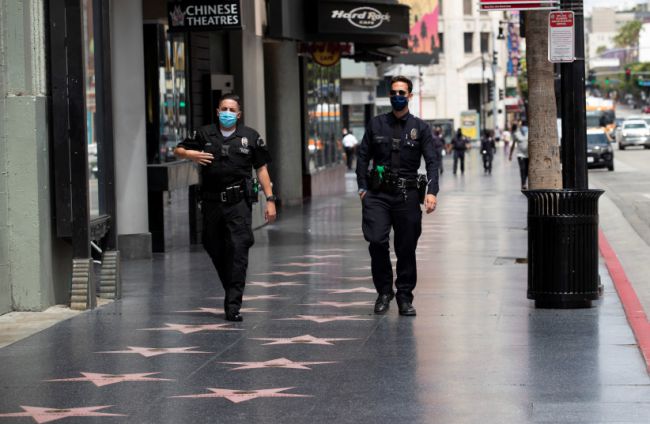
LAPD Officers wear face masks as they patrol Hollywood Blvd during the outbreak of the coronavirus disease (COVID-19), in Los Angeles, California, U.S., May 18, 2020.
(photo credit: REUTERS)
SACRAMENTO, Calif. – The United States set single-day records for new infections and deaths on Thursday as California’s governor said he would impose some of the nation’s strictest stay-at-home orders in the coming days when intensive care units are expected to reach capacity.
More than 211,762 new cases and 2,858 deaths were confirmed as of Thursday evening by a Reuters tally. Hospitalizations topped 100,000.
California’s latest round of restrictions, going further than any other U.S. state, will be triggered on a region-by-region basis when available ICU-bed space falls to 15% of capacity in any of five geographic areas.
Governor Gavin Newsom said four of the regions, including Southern California, were on track to reach the 15% threshold this week, with the San Francisco Bay area expected to follow by mid- to late December.
The stay-at-home restrictions will begin with 48 hours’ notice and remain in place for at least three weeks once they are ordered. California is the most-populous U.S. state, with almost 40 million residents.
“If we don’t act now, our hospital system will be overwhelmed. If we don’t act now, we will continue to see the death rate climb,” Newsom said in a livestreamed news briefing from his home in suburban Sacramento.
Under the clampdown, Californians will be required to remain at home and avoid travel except as needed for permitted activities, such as grocery shopping, medical appointments, dog walks and individual outdoor exercise.
The order, when activated, also places new restrictions on a host of commercial activities.
‘PEOPLE ARE HURTING’
“In the absence of any sort of real funding or support to people who have been out of work for the last 10 months, I think (the orders) are pretty severe,” said West Hollywood resident Cruz Resendiz, 32. “People are hurting, they’re hurting really bad.”
Newsom stressed that the measures, while tough, would be temporary, as vaccines from several pharmaceutical companies were nearing U.S. regulatory approval. Plans call for healthcare workers and nursing home residents to be first in line for the vaccine, which health officials say could arrive as early as mid-December.
State and local authorities across the country have ordered a wide range of limitations on social and economic life in hopes of blunting an alarming resurgence of coronavirus infections after a late-summer lull.
The public health crisis has taken on more dire dimensions following a week of Thanksgiving holiday celebrations in which millions of Americans disregarded warnings against traveling and large gatherings. Health experts predict that an even greater surge could kill about 3,000 people a day over the next two months.
Globally, the coronavirus death toll stood at 10,000 people every day on average over the past week, amounting to 1.5 million since the start of the pandemic, according to the Reuters tally.
Dr. Robert Redfield, director of the U.S. Centers for Disease Control and Prevention (CDC), said earlier this week that December, January and February were likely to be “the most difficult time in the public health history of this nation.”
“Before we see February, we could be close to 450,000 Americans that have died from this virus,” Redfield said. At least 273,000 people in the United States have perished from the virus since February.
HOPES PINNED ON VACCINES
Besides the loss of life, healthcare systems across the country face the prospect of resources and personnel being strained to the point of collapse.
In the Midwest, Governor Mike DeWine said on Thursday that Ohio’s hospitals “not only remain in crisis but the crisis is worsening,” as his state reported its fifth-highest case count of the pandemic.
Michigan Governor Gretchen Whitmer said on Thursday she may extend a three-week “pause” on some private and economic activities.
Vaccines offer a ray of hope, with two promising candidates poised to receive emergency use authorization from the U.S. Food and Drug Administration this month.
But inoculations face reluctance from significant numbers of Americans who are wary of the safety of vaccines developed at record speed. Some also reject calls by political leaders to wear face masks in public and socially distance.
Former U.S. Presidents Barack Obama, George W. Bush and Bill Clinton have volunteered to get their COVID-19 shots on television to promote their safety.
President-elect Joe Biden said on Thursday he would also publicly take a coronavirus shot. He has asked the nation’s top adviser on the pandemic, Dr. Anthony Fauci, to stay on under the Biden administration.
At least one former skeptic said she and her husband would take the vaccine, given the surge in infections and her high blood pressure and age, which increase her risk of severe illness.
“I didn’t think I’d say this, but right now, yeah, I absolutely would,” said Nina Lyons, 65, a retiree living in Pittsburgh. “I trust it. And if there’s repercussions along down the line I am going to say that it’s worth taking that risk.”y that it’s worth taking that risk.”
